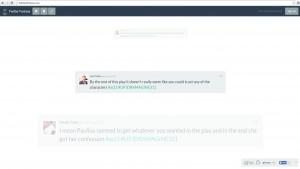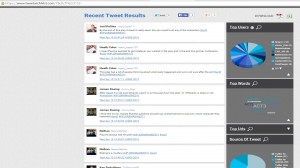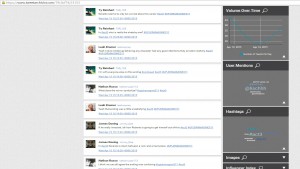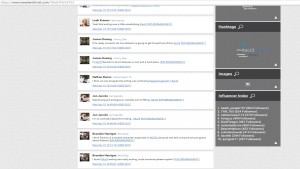Just a back-up link!
Category Archives: Uncategorized
Pedagogical Intervention 1: Microblogging: Being a Twitterdactyl in the 21st Century Classroom
Twitter is currently a staple of my 300-level Dramatic Imagination literature course. The following is extracted from my syllabus:
Breakdown of Grading Criteria
Weekly Responses (10 x 15 points each) 150 points
Each week will be dedicated to a single dramatic work. We will be constructing multi-media responses outside of class that will cushion our classroom discussions. Weekly responses will be evaluated in two ways:
1. Class Twitter Posts [5 points]
–For each act per play we read, you must post at least two class tweets per act. When we utilize Twitter as a classroom tool, please remember to always #UPJDRAMAGINE311 and what #Act (#scene and #line, when applicable) so that our class is able to easily locate posts and that I am able to document your participation.
–Please get into the habit of collaborating with your fellow students. Our learning community is one that extends beyond the boundaries of the classroom, itself. Note: If you have your Twitter account set to private, we will not be able to see your class tweets.
Twitter Value
It is already relevant to students’ lives. We talk about utilizing programs that are generic and temporary within the university system. While social media also occupies a temporal space, (i.e. MySpace) at least this space is always occupied. Twitter is something that students are currently (and constantly) using outside of the classroom. This is an easy and effective tool to bridge the gap between classroom-dorm-room contexts.
The 140-character blog value
Advantages:
- There are definite pedagogical values to this micro-composition. Molds critical thinking + critical composition with form + content + creativity. Articulating our thoughts into meaningful communication: challenging, forces us out of passive voice, into direct modes of communication (think how difficult one-page teaching philosophy is; try fitting a DQ into a tweet. It is tough. Trust me.)
Disadvantages:
- 140-characters is not an effective way to ensure comprehension of active engagement with the material
How to counter disadvantages:
- Provide specific guidelines for the types of Tweets that you expect with a minimum quota. See my guidelines for the Dramaginator Twitter requirements:
Dramaginator Tweet Log
_____/3 At least 1 general discussion question per Act
_____/3 At least 1 discussion question per Act that includes theory or other elements of drama/dramatism
_____/2 At least 2 discussion questions/comments that relate to the assigned secondary source for the play
_____/2 At least 2 comments in relation to the course theme of struggle/conflict
_____/1 Link to the secondary source of which you are presenting on (scholarly article, biographical piece/website, website of the author, history of the play’s production, or other source pertaining to the text that aids our collective understanding of the text and/or brings a new perspective of the events or histories that we are examining)
_____/1 Link to YouTube (or other) video of either your favorite recorded performance or of your favorite/most important lines of the play. Must note which Act, scene, lines
_____/1 Photograph, meme, illustration, painting, or other visualization that encompasses the crux of the struggle of the drama
_____/3 Respond to at least 3-4 tweets of others
- Implement a more cohesive response assignment. For me, weekly discussion board responses that are student-generated questions:
2. Discussion Board Summative Response [15 points]
In addition to our class Twitter posts, we will also be constructing individual summative responses each week, due every Friday by 11AM. Some Friday exceptions apply, so be sure to note the “Reminders” throughout the syllabus where this is applicable. You will post your response in two ways:
i. Copy & paste into the Discussion Board forum assigned for that play.
ii. Attach a Word document with the same response.
In these online posts, you will choose a question or focal point to address. You will have a variety of options, based on forums that the Dramaginator of the week creates for our class. You must identify which option you will be writing to in your response.
These responses will be 250-500 words per post and must include applied and recognized terms and theories of drama/dramatism.
Classroom Applications of Twitter
—Discussion Tool
—Collaborative Resource (don’t know a classmate’s e-mail? That’s okay, we’re all on Twitter. Makes group work and group projects much easier.)
—Publication (University acknowledgement: starts a buzz)
Visualization Tools
Customization Analysis Legend:
Minimal: 1-3 items Moderate: 4-10 items High: 11+ items
1. Visible Tweets: http://visibletweets.com/home.htm
Directions: Type in the hashtag of tweets that you want to visualize (you do not need a Twitter account to do so)
Visualization options/customization: Yes; Minimal
Free version: Tweets fetched every 5 minutes
$ version: can e-mail visibletweets@themainblue.com for a quote that offers a more customizable version of Visible Tweets that features your own logo, colors, fonts, Tweets fetched in real-time, and the option to moderate and filter tweets
Best features: Relatively decent selection of tweets, can customize visualization via tag cloud
Thumbs down features: Often slow-loading on university-wide systems, repetitive of most recent tweet visualizations (if large class as I have, this is negative)
#UPJDramagine311 Visible Tweets
2. Tweet Wally: http://www.tweetwally.com/
Directions: Sign in with your Twitter account
Visualization options/customization: Yes; High
Free version: Recent tweets; seems within 24 hours of posting
$ version: —
Best features: Publishable pages, filtered tweets, named pages, multiple viewing options, ability to include description, multiple display options, embed features, “Help” features for keyword search; useful for my grading system (which my grading system may not be so useful, suggestions are welcome!)
Thumbs down features: Problems searching into past tweets; seems to be useful for current tweets only
3. Twub: http://twubs.com/
Directions: Type in the hashtag of tweets that you want to visualize or in with your Twitter account
Visualization options/customization: No
Free version: Use to embed and share a feed, host and schedule a chat based on your registered hashtag
$ version: It’s free, unless using for an event (corporate), then lowest cost is $99/month
Best features: Can embed the feed, choose the speed of feed, schedule/host a live chat (promotes conversational engagement), register your hashtag (publish), invite others, opportunities for inter-university relations, control the feed
Thumbs down features: Seems more like a corporate chat room; the embedded feed is the single best feature
4. Twitter Fontana: http://twitterfontana.com/
Directions: Type in the hashtag of tweets that you want to visualize or sign in with your Twitter account
Visualization options/customization: Yes; High
Free version: Visual display of tweets
$ version: —
Best features: Variety of visualization and aesthetic customization: one or many tweets on the screen, opens avenues for different types of discussion activities, ability to control the feed (pause for discussion purposes)
Thumbs down features: Cannot embed or share specific tweets/hashtags; it always goes to homepage
5. Tweet Archivist: https://www.tweetarchivist.com/
Directions: Type in the hashtag of tweets that you want to visualize or in with your Twitter account
Visualization options/customization: No
Free version: Can view analysis, one time
$ version: Need to pay for valuable results other than just one time
Best features: Can view multiple analyses and patterns of tweets: “top influencer” index, hashtags, images, user mentions, volume of tweets over time, sources of tweets, top words, top contributors, if paid for, can download data in PDF or Excel file.
Thumbs down features: Similar to our discussions with how/why to use Voyant, how/why to catalog and log the frequencies of topics other than tracing and themes and intersections of academic conversation, I’m not sure what else this could be used for; also, $
6. Hastagify: http://hashtagify.me/
Directions: Type in the hashtag of tweets that you want to visualize or in with your Twitter account
Visualization options/customization: Yes; High
Free version: Can view multiple and various forms of analyses
$ version: Can pay for “Hashtags Lab,” an even more in-depth analysis of how your hashtag basically influences lives.
Best features: #1 Feature=Hashtag Wall: Great and aesthetic way to view multiple tweets at one time, effective way for discussion activities; Can view multiple analyses and patterns of tweets: usage patterns, basic, modern, and table-style of analyses, related hashtags, popularity trends, spelling variants of the selected hashtag,
Thumbs down features: Similar to our discussions with how/why to use Voyant, how/why to catalog and log the frequencies of topics other than tracing and themes and intersections of academic conversation, I’m not sure what else this could be used for;
Audiences and Purposes
#18: Electronic Sources: Audiences and Purposes (Schreibman, Siemens, and Unsworth) provides to us the argument and complications surrounding the purpose and function of electronic texts.
Birkerts and Baker seem to share some of the same anxieties that we have been discussing all semester: the threat of codex extinction. They both “mourn the changes wrought by the development of electronic media, and fear that books, once decoupled from their physical presence, will lose their meaning and historical importance.” While I don’t think we are close to a Fahrenheit 451 post-codex-apocalypse, I understand and share some of their anxious notions. In conversation with procuring electronic texts, however, the rebuttal to this possibility and fear is that electronic texts may actually do the opposite, as this chapter indicates that Birkerts, specifically, “does not consider other possible outcomes, such as one in which general readers and scholars alike have a better sense of the concerns and ideas of peoples and historical periods with increased access to works otherwise available in only a few libraries.” While I agree that the increase of access provides a larger space and opportunity to interact with rare texts, I don’t think that it directly responds to the possible extinction of the codex. Even the authors’ response to this does not clearly answer that: “The development of digital collections does not require the destruction of books; instead, it may provoke more interest in their existence and provide different opportunities for their study through keyword and structured reading.” To me, this doesn’t answer the concern of Birkets and Baker. Even though this process “does not require the destruction of books,” the possibility of the extinction of the codex is not ruled out.
There is also the issue of access. Electronic digitizations of texts simply for access seems to miss the point, according to Hockey, where “access is the least interesting aspect of electronic texts, for it leaves largely unexploited their real power: the ability for texts to be searched and manipulated by computer programs.” For me, and perhaps for the electronic text collections available, Hockey’s stance on what should be the focus of electronic texts seems to be a bit ahead of the game, at this point. It seems that gaining access to a wide range of texts is the fundamental first step toward anything more complex, such as Hockey’s suggestion for electronic text possibilities.
While there is an array of electronic texts available, it is also very limiting: “The initial hindrances to reading works by lesser-known writers, perhaps insurmountable in the past, can be much more easily overcome in this new medium.” While this is true, those texts also need to be made available. Progressing through the chapter, it is clear that finding out what exactly is available is an “immediate problem” since there is no institutionalized cataloging order of what electronic collections are available. It seems to me, that perhaps before dedicating the studies in this field to all that it can be, there needs to be some rational organization of material, increased standards for electronic collections (publisher and edition choices, for example), and an e-Dewey-type system for categorization before the shift to digital humanities can be curbed to anticipate and refute the foundational concerns of skeptics.
Tech-Impaired Anonymous
Hi. My name is Michaela (audience members: “Hi, Michaela”) and I am technologically handicapped. My support groups consists of online forums with equally technologically-retracted human beings who also do not know the answers to my questions. My personal readings outside of our assigned readings have been PDF excerpts of HTML for Dummies that are scattered online. This is the 5th attempt at posting this blog post from two weeks ago, which has somehow led to “failure: internal data corruption” or similar variant pop-ups between clicking on the “Publish” button on my computer screen and what should ideally happen. Thankfully, my tech-handicap has taught me (the hard way) to save and re-save multiple back-ups of things.
This is where I’ve been.
I have been trying to pull both sides of my brain into working together with this stuff, but it is difficult. I am sharing my difficulty with technology in this blog not only to excuse my lack of blogging, but because I feel that even though our students are, most likely, more tech-savvy than we are, there are moments such as the ones that I am having, that address our students daily within our classrooms–either with or without technology.
I think one of the most important things that I have realized from my experiences thus far with all of the programs, code, intricate readings saturated with tech terms, and IF frustrations, that turning on to
technology doesn’t have to be such a turn off for the tech-impaired.
In some ways, I think that I have been focusing on the wrong aspect of these tools. I shouldn’t drown myself in code or alien data language or (insert techy jargon quip here) to locate a deeper understanding of the Digital Humanities Web Experience. It is much more than the foundations that lead the way to an entirely different hierarchical level of critical thinking.
In other ways, I am finding some different perspectives on digital humanization. When attempting to blog and comment on others’ sites after the first few blogs (which were magically problem-free), I noticed that though I had been participating by reading other blogs and formulating my own responses, I feel like I had been missing out because my work or coordinating responses were not “published.” I’m not sure how to put my finger on it, but the act of engaging through this interface requires the Lacanian “Big Other” to make it count.
While I still grapple with meaningful ways to incorporate the discussion board (as I am doing in my classes right now) and genuinely participate in them (such as this blog), I’m OK with the fact that I’m still not quite sure where these things land for me or how to articulate them within the larger theme of this class.
However, I do know that picking up a bunch of tools because they are on sale and expanding the toolbox
isn’t going to make me a better educator. But, I also realize that these tools must fit a purpose.
Hello world!
Welcome to your brand new blog at Indiana University of Pennsylvania Sites.
To get started, simply log in, edit or delete this post and check out all the other options available to you.
For assistance, visit our comprehensive support site, check out our Edublogs User Guide guide or stop by The Edublogs Forums to chat with other edubloggers.
You can also subscribe to our brilliant free publication, The Edublogger, which is jammed with helpful tips, ideas and more.



